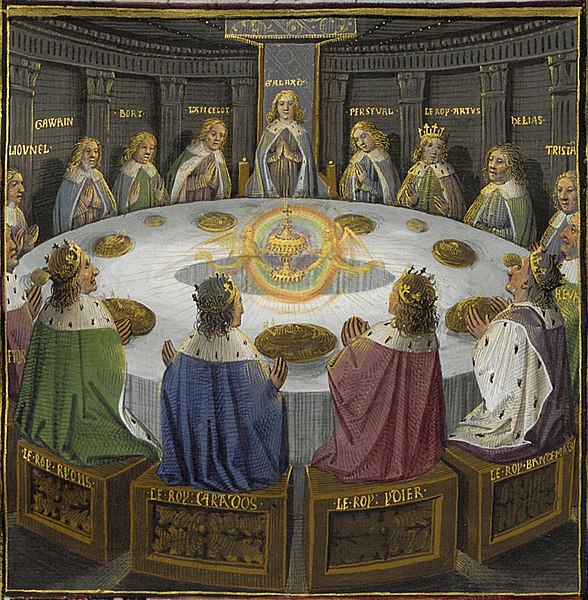
King Arthur and his Knights of the Round Table, painted by Évrard d’Espinques ca. 1475
When I did a series on names invented for literature a few years ago, I deliberately left out name from Arthurian legends and stories because I wanted to do a separate series about them. Some of these names existed prior to their use in Arthurian stories, while others were created just for the stories.
FYI: These names come exclusively from classic Arthurian works, not modern films, TV shows, and games.
Accolon, sometimes spelt Accalon, is of unknown origin. He’s a Gaulish knight and a lover of Morgan le Fay.
Aeddan is the Welsh form of the Irish name Aodhán, which is a diminutive of aedh and means “little fire.” He’s an enemy of King Arthur.
Aelens is the King of Iceland and father of King Arthur’s follower Escol.
Agravain is a nephew of King Arthur.
Agrestes derives from the Latin word agrestis (rural, wild, rustic, brutish), which in turn comes from ager (farm, field). He’s an ancient King of Camelot.
Amaethon derives from the Brittonic name *Ambaχtonos (ploughman-god, Divine ploughman). He’s the Welsh god of agriculture and an Arthurian warrior in the late 11th century legend of Culhwch and Olwen.
Amr, or Amhar, is King Arthur’s son in the 9th century chronicle Historia Brittonum.
Andret is the nephew of King Mark of Cornwall and an enemy cousin of Tristan.
Anfortas probably comes from the Old French word enfertez or enfermetez (infirmity). This is the name of the wounded Fisher King in the 12th century Arthurian epic Parzifal.
Anguish is the King of Ireland and Iseult’s father.

Arthur may derive from the Celtic roots *artos (bear), and *wiros (man) or *rīxs (king). It may also come from the Roman family name Artorius. The jury is still out on whether King Arthur were a real person, based on a semi-legendary figure, or entirely fictional.
Bagdemagus is the King of Gorre and a Knight of the Round Table. Some scholars believe Bagungus, the name of a character who only appears in Laghamon’s 1190 epic poem Brut, is a corruption of Bagdemagus on account of its rarity.
Balin is one of King Arthur’s knights.
Bedivere comes from the Welsh name Bedwyr, which may derive from roots bedwen (birch) and gwr (man). He’s one of King Arthur’s original friends, and throws the sword Excalibur into a lake to fulfill King Arthur’s dying wishes.
Bellangere derives from the Ancient Germanic name Berengar, which in turn comes from roots bern (bear) and ger (spear). It may also have been inspired by French roots bel, beau (beautiful, great, fine) and anger (anger), and thus means “righteous anger.” He’s a Knight of the Round Table.
Bors comes from the French name Bohort and possibly the Old French root behort or bohort (“jousting lance” or “jousting”). He’s a Knight of the Round Table.
Brunor probably derives from the Ancient Germanic root brunna (armour, protection) or brun (brown). Several Arthurian characters bear this name, including Sir Galehaut’s father.

Cador is probably a Cornish form of the Welsh name Caderyn, which means “battle king” and derives from Old Welsh roots cat (battle) and tigirn (monarch, king). He’s Lady Guinevere’s guardian, King of Cornwall, and the father of King Arthur’s successor Constantine.
Calogrenant, sometimes spelt Colgrevance, is a Knight of the Round Table.
Caradog, or Caradoc, comes from Old Welsh name Caratauc and ultimately the Brythonic name *Caratācos, which derives from Old Celtic root *karu (to love) and means “loved.” He’s a Knight of the Round Table.
Claudas is an opponent of King Arthur.
Culhwch means “hiding place of the pig” in Welsh. He’s a cousin of King Arthur.
Dagonet possibly derives from the Old English word dæg (day). He’s a Knight of the Round Table, usually described as foolish and witless. Eventually he evolved into King Arthur’s belovèd court jester.
Dinadan may derive from Dinn Eidyn (Castle of Edin), the old name for the Scottish city of Edinburgh. He’s a Knight of the Round Table and a good friend of Tristan.

The Knights Of The Round Table Summoned To The Quest By A Strange Damsel (The Summons), by Edward Burne-Jones
Ector is King Arthur’s foster father and Sir Kay’s foster father.
Edern derives from Old Welsh root edyrn (heavy, immense; wonderful, prodigious, marvellous). Previously, it was wrongly believed to come from the Latin word aeternus (eternal). Edern is a Knight of the Round Table and one of King Arthur’s most important counsellors during a battle between Saxons and Danes.
Elyan probably ultimately derives from the Roman family name Aelius, which in turn may come from the Greek word helios (sun). He’s a Knight of the Round Table and the son of Sir Bors. In some stories, he’s also a cousin of Sir Lancelot.
Escanor may derive from the Old Irish name Escae, which in turn comes from Proto–Celtic Eskyom and ultimately Proto–Indo–European H,eysk, which means “to shine, to glitter” and is usually associated with the Moon. King Escanor the Large is an antagonist killed by King Arthur’s nephew Sir Gawaine.
Escol is a follower of King Arthur.
Evelake derives from Evalach, which is probably corrupted from the Middle Welsh name Afallach and the word afall (apple). It may also be a form of the Celtic name Abellio, which some scholars believe ultimately comes from Apollo and thus may be related to the Indo–European root *apelo- (strength). King Evelake of Sarras is the first person to possess the shield destined for Sir Galahad.
Feirefiz is the halfbrother of the title character in the abovementioned epic Parzifal.










